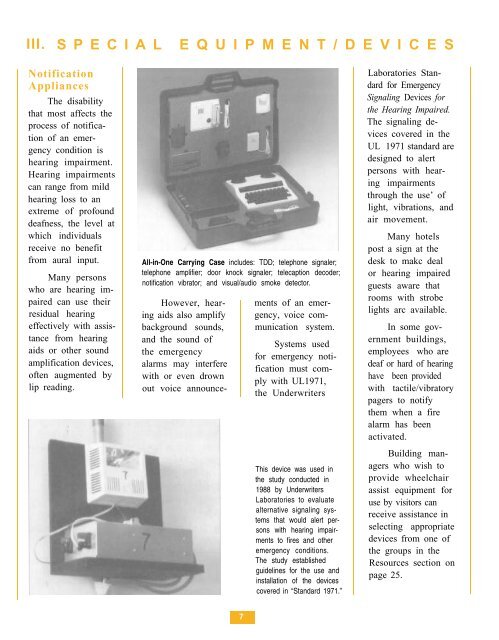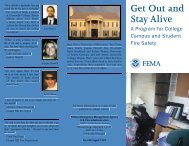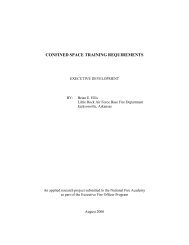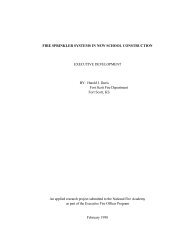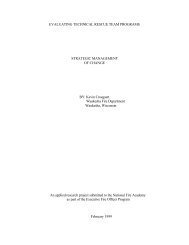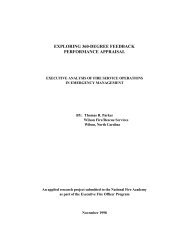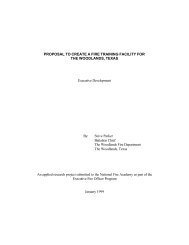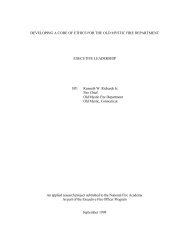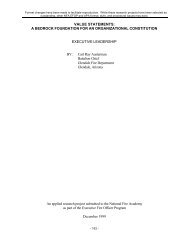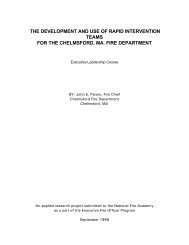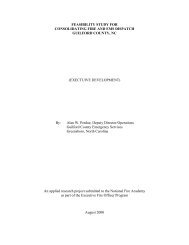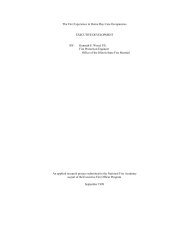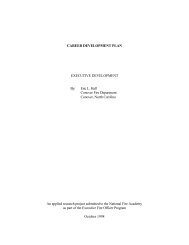Emergency Procedures for Employees with Disabilities - US Fire ...
Emergency Procedures for Employees with Disabilities - US Fire ...
Emergency Procedures for Employees with Disabilities - US Fire ...
Create successful ePaper yourself
Turn your PDF publications into a flip-book with our unique Google optimized e-Paper software.
III. SPECIAL E Q U I P M E N T / D E V I C E S<br />
Notification<br />
Appliances<br />
The disability<br />
that most affects the<br />
process of notification<br />
of an emergency<br />
condition is<br />
hearing impairment.<br />
Hearing impairments<br />
can range from mild<br />
hearing loss to an<br />
extreme of profound<br />
deafness, the level at<br />
which individuals<br />
receive no benefit<br />
from aural input.<br />
Many persons<br />
who are hearing impaired<br />
can use their<br />
residual hearing<br />
effectively <strong>with</strong> assistance<br />
from hearing<br />
aids or other sound<br />
amplification devices,<br />
often augmented by<br />
lip reading.<br />
All-in-One Carrying Case includes: TDD; telephone signaler;<br />
telephone amplifier; door knock signaler; telecaption decoder;<br />
notification vibrator; and visual/audio smoke detector.<br />
However, hearing<br />
aids also amplify<br />
background sounds,<br />
and the sound of<br />
the emergency<br />
alarms may interfere<br />
<strong>with</strong> or even drown<br />
out voice announce-<br />
7<br />
ments of an emergency,<br />
voice communication<br />
system.<br />
Systems used<br />
<strong>for</strong> emergency notification<br />
must comply<br />
<strong>with</strong> UL1971,<br />
the Underwriters<br />
This device was used in<br />
the study conducted in<br />
1988 by Underwriters<br />
Laboratories to evaluate<br />
alternative signaling systems<br />
that would alert persons<br />
<strong>with</strong> hearing impairments<br />
to fires and other<br />
emergency conditions.<br />
The study established<br />
guidelines <strong>for</strong> the use and<br />
installation of the devices<br />
covered in “Standard 1971.”<br />
Laboratories Standard<br />
<strong>for</strong> <strong>Emergency</strong><br />
Signaling Devices <strong>for</strong><br />
the Hearing Impaired.<br />
The signaling devices<br />
covered in the<br />
UL 1971 standard are<br />
designed to alert<br />
persons <strong>with</strong> hearing<br />
impairments<br />
through the use’ of<br />
light, vibrations, and<br />
air movement.<br />
Many hotels<br />
post a sign at the<br />
desk to makc deal<br />
or hearing impaired<br />
guests aware that<br />
rooms <strong>with</strong> strobe<br />
lights arc available.<br />
In some government<br />
buildings,<br />
employees who are<br />
deaf or hard of hearing<br />
have been provided<br />
<strong>with</strong> tactile/vibratory<br />
pagers to notify<br />
them when a fire<br />
alarm has been<br />
activated.<br />
Building managers<br />
who wish to<br />
provide wheelchair<br />
assist equipment <strong>for</strong><br />
use by visitors can<br />
receive assistance in<br />
selecting appropriate<br />
devices from one of<br />
the groups in the<br />
Resources section on<br />
page 25.


